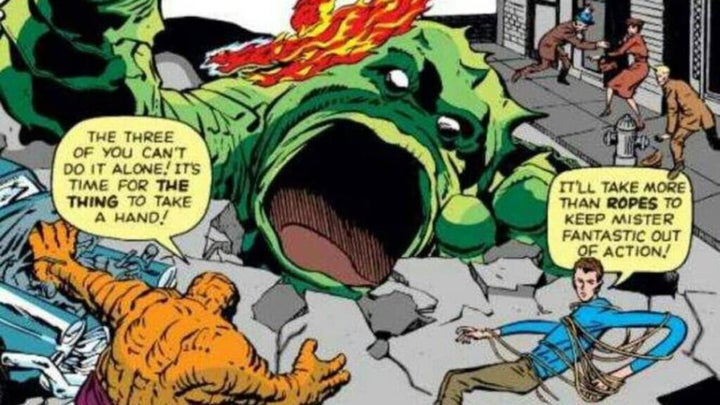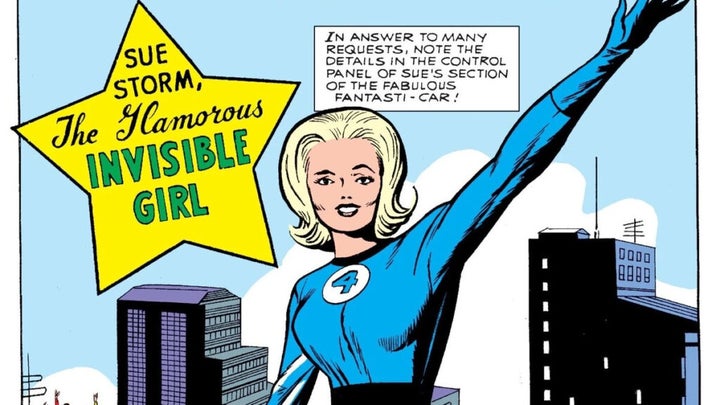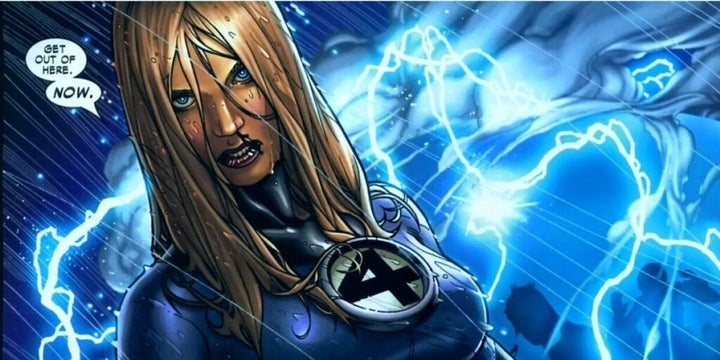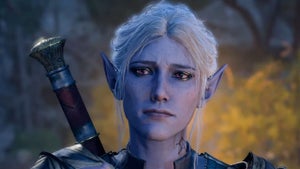News
From Invisibility to Power: The Evolution of Sue Storm in Marvel Comics
From Girl to Woman

- March 24, 2023
- Updated: August 26, 2024 at 7:07 AM

“Sue Storm, The Invisible Girl. Favorite hobbies: fashion, cooking, cosmetics and reading romance novels“; “If she marries, will she leave The Fantastic Four? Your guess will be as good as ours – it’ll probably depend on who she marries!”. The first annual Fantastic Four comic book created a profile of the girl in the group that even at the time gave some pause. Stan Lee didn’t know what to do with the character, her power was the weakest and readers didn’t want her on the team. So how has she survived to this day as the most important and powerful character in Marvel’s First Family?
Having tea and looking at dresses
The Fantastic Four were born in 1961, at the height of the Yankee economic boom: World War II had ended fifteen years earlier and Vietnam was still an exotic country that most Americans had never heard of. Superman had been flying over the skies of Metropolis for 23 years and in the offices of Marvel, a company that had just changed its name from the classic Timely, Jack Kirby and Stan Lee were preparing the first comic book of a collection that would change everything.

The Fantastic Four is the first superhero comic in which the heroes are, within their capabilities… human. They show imperfections, they are everyday people and, in addition, they fight against strange alien villains or, in a propaganda twist that bordered on the absurd, from beyond the Iron Curtain. A family of superheroes. Reed Richards, the adult; Johnny Storm, the teenager; Ben Grimm, the bronco… And Susan Storm, who under Stan Lee’s rule had the personality of “the girl”.
Do you know why Sue gets into the space trip that would later give them powers? Because Reed “is her fiancé, and where you go, I go.” In her day, with a female stereotype sustained by I Love Lucy and romance comics, this was what was expected of her. A woman who, paradoxically, made herself… invisible. While her companions could boast extravagant powers (the Human Torch, Mister Fantastic, the Thing), she stood aside, usually adopting the role of damsel in distress. And the public began to take notice.

You should throw her out
On the mailing page of issue #6 it’s a Martin Ross who opens fire on Sue: “She’s the greatest! But I think you should kick Susan Storm out. She never does anything”. These two lines – who said Twitter invented being a hater? – led to an explosion of people for and against that culminated in a little story where the characters read the letters and tried to explain that she was essential to the group.
“Some readers say I don’t contribute enough, that you’d be better off without me! And maybe they’re right,” Sue lamented before Reed and Ben set the record straight, comparing the superheroine to Abraham Lincoln’s mother, culminating with “If you want to see women fighting, go watch women’s wrestling!” and presenting “our favorite sidekick” with a birthday cake. Not before leaving her not knowing what to say and the Thing surprised (“First time I’ve ever heard a woman say something like that!”). It was the time.
Sue Storm was gaining importance in the plots, especially as the focal point of the love triangle between Reed and Namor, but mostly as a comic counterpoint who always made references to cleaning or buying high-end dresses. Sue was a superheroine in a world of heroes where she could only be compared to The Wasp, Ant-Man’s sidekick. She could save the day from time to time, but not even the advancement of women’s rights could prevent that, once she gave birth to Franklin in 1968, no one at Marvel knew what to do with her.
The invisible woman
Sue became a housewife, a character who listened to others and who, at any given moment, could change the course of a battle with her force fields or her psionic rays, but it took John Byrne to turn everything upside down and give her the role she deserved in the Marvel Universe. Not as a mother or a wife, but as one of the most powerful women in the world.

The Invisible Girl became The Invisible Woman, her powers grew in intensity, she began to develop her own personality beyond Reed and Johnny… And finally, in Civil War, they decided to turn her into everything she was and more. Confronted in the superheroic battle, Sue ended up writing a letter to Reed where she made her intentions clear: “Johnny and I will be working underground from now on, and obviously there is no room for Franklin and Valeria. That’s why I’m leaving you to look after them and asking you to give them the time you’ve so often denied them in the past.” Boom.
Civil War may not have been the best comic book in the world, but it was, 45 years after its creation, the final awakening of a character who would never again wear an apron and keep quiet behind her husband. From the teenager obsessed with dresses to the independent woman, dozens of writers and cartoonists have shaped her over the years. The submissive Sue of the early 60s made sense in her context, but we live better knowing that the Invisible Woman was always the most fantastic of the four. Now it just remains to be seen if the next Marvel movie will be able to understand that.
Editor specializing in pop culture who writes for websites, magazines, books, social networks, scripts, notebooks and napkins if there are no other places to write for you.
Latest from Randy Meeks
- From the random button to interactive series: the 5 biggest mistakes in Netflix history
- The 6 best animes you can't miss this spring
- The psychedelic PlayStation video game that was actually an artistic project that no one understood
- The Switch 2 has disappointed me with its luxury prices for a premium remake
You may also like

Exodus, the Mass Effect of Wizards of the Coast, will expand beyond the video game
Read more

The new PlayStation 5 update adds a perfect accessibility feature for competitive gaming
Read more

Apple's AI smart glasses are in development and their launch is expected in 2027
Read more

The RTX 5070 Ti outperforms the Mac Studio in creative tasks
Read more

Larian comments on what the main aspect they are focusing on in their next game after Baldur's Gate 3 is
Read more

A player in Pokémon GO accumulates millions of experience points because of a particular Pokémon
Read more